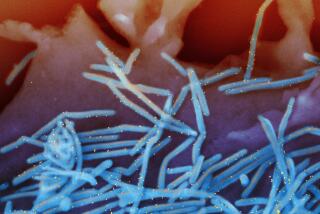Test Launched to Study Shingles Vaccine
- Share via
A new experimental vaccine to prevent shingles, a painful rash common in elderly people, is to be tested in a five-year study that will recruit more than 37,000 older Americans.
The study of the shingles vaccine, sponsored by the National Institutes of Health, was launched in Bethesda, Md., last week when NIH pediatrician Philip A. Brunell, 68, an expert on the virus that causes the disease, became the first volunteer to receive an injection.
For the record:
12:00 a.m. July 5, 1999 For the Record
Los Angeles Times Monday July 5, 1999 Home Edition Health Part S Page 3 View Desk 2 inches; 60 words Type of Material: Correction; Wire
Shingles--A Washington Post article that appeared in the Health section on June 28 incorrectly described the sponsor of a new study on a shingles vaccine for elderly people. The sponsors are the Department of Veterans Affairs (which is leading the study and coordinating the data) and Merck & Co., the vaccine manufacturer. The National Institute of Allergy and Infectious Diseases helped to plan the trial and recruit patients.
To test the product’s effectiveness in preventing shingles, half of the volunteers will receive the vaccine and half will be given a placebo. They won’t be told which they get.
“I hope I get the vaccine,” Brunell joked earlier last week.
Shingles strikes between 200,000 and 500,000 Americans each year, most of them over age 50. Brunell said it is caused by a reactivation of the chickenpox virus, which survives lifelong in the nerves of people who have had that illness.
The virus, called varicella zoster, lives in the ganglia of sensory nerves--collections of nerve cell bodies located near the spinal cord. Most of the time, the body’s immune system keeps it in check. But in healthy elderly people--and sometimes in younger people infected with the human immunodeficiency virus (HIV) that causes AIDS--that immunity may wane. Then the varicella zoster virus may reactivate, producing severe pain and a crop of blisters in the area served by one of the nerves that carries sensation from the skin to the spinal cord. Depending upon which nerve is affected, the rash can crop up on virtually any part of the body.
The shingles rash usually disappears after a couple of weeks, but the pain may persist.
“The pain can last for months,” Brunell said. “And it’s debilitating. It’s severe enough to interfere with sleep. Some people can’t even put on clothes.”
Since there’s no good treatment for shingles pain, the best course would be to prevent the illness. That’s the aim of the new vaccine, manufactured by Merck & Co., which contains a live, weakened version of the varicella zoster virus. Brunell said evidence suggests it can prevent shingles by boosting immunity. In earlier trials, the only significant side effect was occasional pain, redness or tenderness for a few days at the site of injection, he said.
People wishing to enroll in the shingles vaccine study must be at least 60 years old and should have lived in the United States for at least 30 years, Brunell said.
Twenty medical centers will test the vaccine. For information, call (877) 841-6251.






